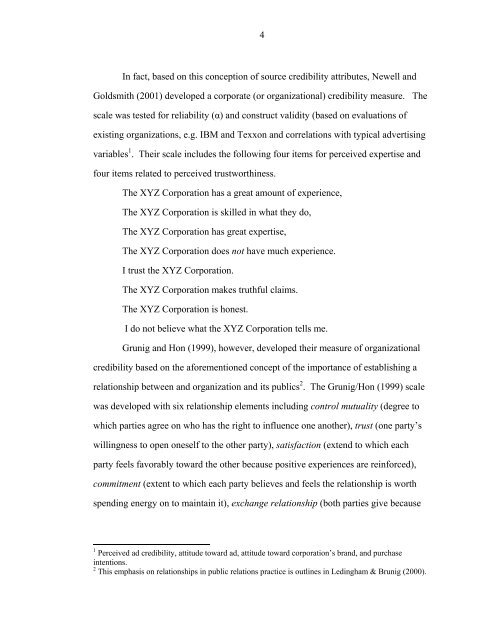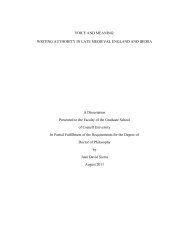Briana Anderson - Cornell University
Briana Anderson - Cornell University
Briana Anderson - Cornell University
You also want an ePaper? Increase the reach of your titles
YUMPU automatically turns print PDFs into web optimized ePapers that Google loves.
4<br />
In fact, based on this conception of source credibility attributes, Newell and<br />
Goldsmith (2001) developed a corporate (or organizational) credibility measure. The<br />
scale was tested for reliability (α) and construct validity (based on evaluations of<br />
existing organizations, e.g. IBM and Texxon and correlations with typical advertising<br />
variables 1 . Their scale includes the following four items for perceived expertise and<br />
four items related to perceived trustworthiness.<br />
The XYZ Corporation has a great amount of experience,<br />
The XYZ Corporation is skilled in what they do,<br />
The XYZ Corporation has great expertise,<br />
The XYZ Corporation does not have much experience.<br />
I trust the XYZ Corporation.<br />
The XYZ Corporation makes truthful claims.<br />
The XYZ Corporation is honest.<br />
I do not believe what the XYZ Corporation tells me.<br />
Grunig and Hon (1999), however, developed their measure of organizational<br />
credibility based on the aforementioned concept of the importance of establishing a<br />
relationship between and organization and its publics 2 . The Grunig/Hon (1999) scale<br />
was developed with six relationship elements including control mutuality (degree to<br />
which parties agree on who has the right to influence one another), trust (one party’s<br />
willingness to open oneself to the other party), satisfaction (extend to which each<br />
party feels favorably toward the other because positive experiences are reinforced),<br />
commitment (extent to which each party believes and feels the relationship is worth<br />
spending energy on to maintain it), exchange relationship (both parties give because<br />
1<br />
Perceived ad credibility, attitude toward ad, attitude toward corporation’s brand, and purchase<br />
intentions.<br />
2<br />
This emphasis on relationships in public relations practice is outlines in Ledingham & Brunig (2000).

















